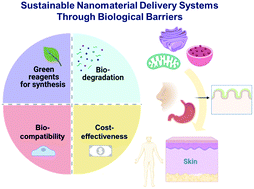Trends and perspectives in bio- and eco-friendly sustainable nanomaterial delivery systems through biological barriers
Abstract
Many policies, including the European Green Deal, have been released to enhance global economic sustainability. Such policies require new materials to be sustainable, cost-effective, and safe for the fabrication of products that comply with regulations and are acceptable to consumers. In this context, the field of bionanomaterials has shifted toward developing green synthesis methods and the use of sustainable and eco-friendly materials. All these have to be considered for clinical applications along with other key issues and challenges in biomedical science including highly efficient targeted delivery of materials and chemicals with minimal toxicity and side effects. Here, we review the various types of inorganic and organic nanoparticles (NPs) used as the delivery vehicles to specific sites in human bodies, and discuss their advantageous properties and functions along with issues and limitations for clinical therapeutic applications. We summarized the strategies that can overcome both biological barriers such as the blood–brain barrier and harsh physiological conditions to realize clinically meaningful delivery systems, and introduced and discussed green synthesis methods for NPs and their environmental impacts. Finally, the perspectives on the biocompatibility, toxicity and environmental consequences of these NPs developed for biomedical applications are provided.

- This article is part of the themed collections: 2022 Materials Chemistry Frontiers Review-type Articles and Functional materials for sustainable future - Vision from Korean scientists


 Please wait while we load your content...
Please wait while we load your content...